L & L Roofing And Construction Of Gainesville Fundamentals Explained
L & L Roofing And Construction Of Gainesville Fundamentals Explained
Blog Article
Indicators on L & L Roofing And Construction Of Gainesville You Should Know
Table of ContentsRumored Buzz on L & L Roofing And Construction Of GainesvilleGetting My L & L Roofing And Construction Of Gainesville To WorkThe smart Trick of L & L Roofing And Construction Of Gainesville That Nobody is Talking AboutL & L Roofing And Construction Of Gainesville Things To Know Before You Get ThisAll About L & L Roofing And Construction Of GainesvilleThe Basic Principles Of L & L Roofing And Construction Of Gainesville Get This Report about L & L Roofing And Construction Of Gainesville
One of the most critical functions of a roof is to stop water infiltration. Normal roofing evaluations and upkeep are vital to maintain your home dry and free from water-related problems.From high-grade products to impeccable workmanship, we guarantee your new roof will certainly serve you well for several years to come. Recognizing the several functions of a roof covering and the relevance of prompt replacement is essential for home owners. Your roofing system is not just a safety covering; it's an integral part of your home's structural integrity, convenience, and worth.
L & L Roofing And Construction Of Gainesville Fundamentals Explained
Asphalt Roof shingles: Structure roof tiles made from asphalt-impregnated really felt covered with mineral granules. * Base Flashing: That portion of the flashing that is connected to or relaxes on the roofing system deck to guide the circulation of water on the roofing system, or to secure versus the roof deck.
Nailed to roof covering deck to hold particular kinds of ceramic tile. Boot: Pre-formed flange positioned over a vent pipeline to secure the roof around the vent pipe opening.
3 Simple Techniques For L & L Roofing And Construction Of Gainesville
Cant Strip: A beveled assistance used at the crossway of the roof deck with vertical surface areas to make sure that flexes in the roof covering membrane to develop base flashings can be made without breaking the felts. Cap Flashing: The Part of the flashing affixed to an upright surface to avoid water from moving behind the base flashing; occasionally described as counter flashing.
* Caulking/ Sealants: Glue sealant used to fill up in small locations against water. Clearstory: The uppermost location of a roofing plane that drops off without intersecting with an additional roofing system aircraft.
Occasionally referred as boot. Conductor: A pipeline for communicating rain water from the roofing seamless gutter to a drain, or from a roofing drainpipe to the tornado drain; additionally called a leader, downspout, or downpipe. Coping: A building device put on top of the parapet wall to work as a cover for the wall.
Getting The L & L Roofing And Construction Of Gainesville To Work
* Curb: A wall of wood or masonry built above the level of the roofing, bordering a roof opening such as for setup of roof covering followers or various other tools. Cricket: An actually peaked saddle building and construction at the back of a smokeshaft to avoid accumulation of snow and water around the chimney.' Deck: The surface area installed over the sustaining mounting participants trusses, to which the roofing material is applied.
Diverter: Made use of to route water. Leak edge: A click for info corrosion-resistant, non staining material used along the eaves and rakes to permit water run-off to drop clear of underlying outdoor decking and/or fascia.
(https://salmon-freesia-nnhkxk.mystrikingly.com/blog/roof-replacement-gainesville-trust-l-l-roofing-for-superior-results)* Side metal: A term associating with brake or extruded steel around the perimeter of a roof covering. Exhaust Air Flow: Air that is normally aired vent or tired from the roof covering dental caries, typically with near the ridge. Growth joint: A gadget used to comprise the movement of growth and contraction. On large roof coverings this provision for the movement of the products creating the wall surfaces, roof deck and roof covering is usually made by purposely dividing the building into areas, and covering splitting up between adjacent areas with the development joint to enable motion yet stay out the weather.
L & L Roofing And Construction Of Gainesville Fundamentals Explained

The purpose of flashing is to avoid the infiltration of water in addition to to offer a drain path in between joints, many generally the joint in between a roof covering and a well. Likewise see steel flashing. Flashing Base: The upturned edge of the watertight membrane layer formed at a roof covering termination factor by the extension of the felts up and down over the cant strip and up the wall for a varying range where they are secured with mechanical fasteners.
The 5-Minute Rule for L & L Roofing And Construction Of Gainesville
Installation of structure roof, at this minimum slope, is not suggested and can leak due to blow back. roof replacement gainesville. Fire Wall: Any wall surface developed for the objective of limiting the spread of fire in a structure. Such walls of solid masonry or concrete typically divide a structure from the structures to regarding a meter over the roof covering
Hip: The angle created by the junction of two sloping roofing system planes. Ice and Water Guard: A layer of waterproofing mounted under the tiles at a roof covering's border, valley ridges. Effect Resistant: The Capability of a roofing material to stand up to damages (e.g. piercing from dropping objects (tree branches and hailstorm), application tools, foot website traffic, and so on.
This item provides property owners an insurance decrease. Insulation: Any of a selection of products designed to reduce the flow of heat, either with vents generally mounted in the soffit or eave of a roof. Lap: To cover the surface of one roof shingles or roll with another. Leads: See Pipes Vent Jack, Lead boot, Lead flashings.
Top Guidelines Of L & L Roofing And Construction Of Gainesville

Report this page